 |
| Home | AVRK | AVNK | KAF | Links |
L'Aviation
Royale Khmère
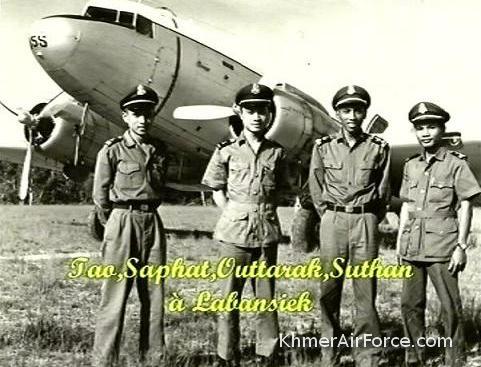 |
|
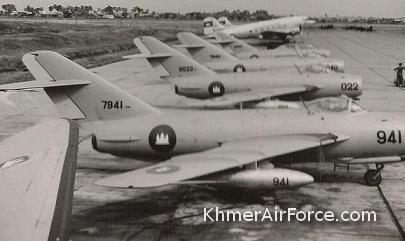 Pochentong |
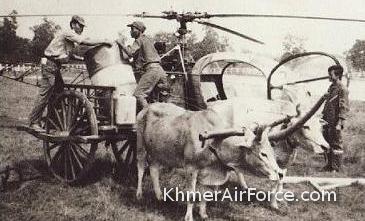 "Les trois frontières" |
1964
With
the will of the kingdom policy, we successively swung from one
superpower nation to another. In 1964, China came with its Mig-17s,
its pilot instructors and a flying training program.
In
1964 during the conflict with the Thais over the disputed Preah Vihear
Temples, the AVRK C-47s dropped several paratroop battalions in the
border area; quickly, a landing strip for the C-47s and An-2s was
improvised to supply the Army troops. After several intrusions into the
Cambodian air-space by Thai airplanes, detachments of MiG-17s and A-1D
Skyraiders were deployed at Siemreap and Battambang. The combat
air patrols often encountered the Thai aircrafts, but there was
no incident; everyone stayed in its own air space.
Tensions
also rose up on the eastern border when, on March 21, 1964, two Khmer
T-28Ds surprised one South-Vietnamese O-1 in Cambodian air space. They
shot it down, killing the pilot and the US observer. In the east region
of Rattanakiri Province, two MiG-17s flown by Capt. Penn Randa and
Capt. Pal Sam Or, surprised two South Vietnamese Skyraiders
inside Cambodia. After a warning cannon-fire burst by Capt. Sam Or, the
South-Vietnamese pilots promptly left Cambodian air space. Frequent air
encounters took place in the eastern region of Kampong Cham Province as
well.
In
another incident, the Cambodian A-1Ds, on their way to intercept
intruders, were fired on by Khmer anti-aircraft artillery who had
mistaken them for Vietnamese Skyraiders. After this incident, the high
command decided to paint an identification red band outlined by blue
borders, the color mimicking our national flag, on the rear fuselage of
the A-1Ds.
There were then several air encounters involving the Khmer MiG-17s and the American F-100s. Very often we saw jet intruders on the radar. Obviously, they too, detected our send in interceptors. When US airplanes were at sight, they were already retreating to the Vietnamese air space. Officially the Americans did not conduct any military operations in Cambodia and they avoided any single incident. Each time, each side broke off without opening fire.
|
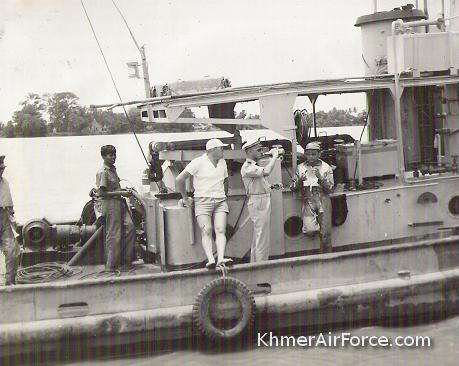 |
In turn, several AVRK transport crews were detached to fly with the national airline company, Royal Air Cambodge (RAC). They upgraded their qualification training on four engine aircrafts like DC-4s, DC-6s, and French made twin jet SE 210 Caravelles with French airline companies UTA (Union Transport Aérien) and Air France that were partners to RAC. Several of them thus obtained their airline pilot license from the International Civil Aviation Organization (ICAO) for international flights connecting Phnom Penh with several important cities in South East Asia.(Manilla, Hong Kong, see complementary note)
In 1964, we welcomed our first physician specialized in Aeronautical Medicine, Doctor So Satta (see the medical service).
1965 A big reversal
Cambodia was now part of the so-called "non aligned countries". With this new political orientation and obligation, it has been decided to buy Yugoslavian UTVA liaison planes. Our aviation will soon be a real live Air museum with samples of airplanes from both East and West block.
In August, 1965, the Thai artillery shelled Cambodian positions at Trad, a small village on the Koh Kong peninsula. The AVRK was about to conduct reprisal strikes. Captain So Satto, Air Tactical Group Commander, planned a bombardment of the Thai positions by the A-1Ds under the protection of the Mig-17s. Fortunately, a cease-fire was reached before the attack. (see complementary notes)
At
the end of November 1965, a new military cooperation mission
delegation went to China. It was a big...
.... reversal in the politics of Prince Sihanouk
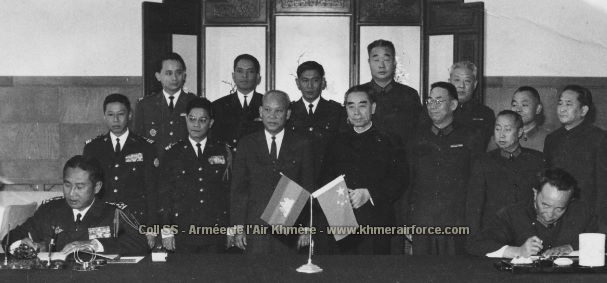
Beijing November 25, 1965
Behind the Cambodian flag, ambassador Troung Cang. Behind the Chinese flag, Chu En-LAi ... see other photos
One more trip, one more mission
for the AVRK but this one had a particular aspect. Once arrived in
China, the chief of mission, Lon Nol, received an order from
the Chief of State Sihanouk. Aside from his mission, Lon Nol must discreetly confirm a
secret treaty consented by Prince Sihanouk authorizing the use of the Kompong Som port
facilities for arms and supply transit for North Vietnamese communists. Disappointed, Lon Nol informed all
the members of his delegation including the AVRK Air Tactical Group
Commander : "This accord makes us lose our neutrality. Our prince allowed the
'thmils’ to come in our country (thmil = Cambodian word for
devil)."
We
were no longer neutral. More precisely, our neutrality
consisted of swinging from one side to another, or playing two cards in the same time.
We are not politicians but we witnessed some of the major politcal
envents of the country.
1967
In 1967, at Samlaut, a peasant revolt burst out against the government. The Army intervened to restore order (complementary notes). Cambodian communists got involved in the revolt and supplied the peasants with arms. The AVRK was deployed to support ground troops. At the end of the year, the Chief of State, Sihanouk, in a surprising move, denounced the interference from China.
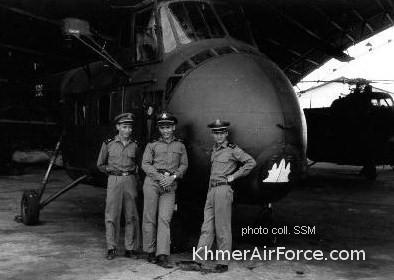 H19 Sikorsky Tan Chhan, Chhim Sophoin, Khun Son Sann |
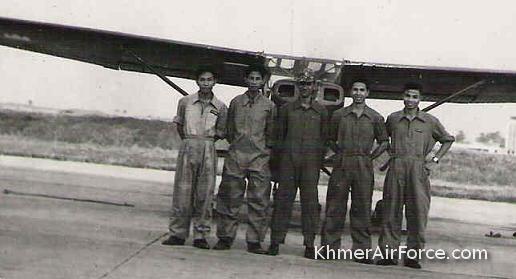 Observation pilots Un Lun Chik, Bun Theng, Long Trasom, Nouth Kimly Vanna, Sok Sap |
Since
1966, the Air Tactical Group had to control and confirms the
intelligence data provided by the Army about the Vietcong sanctuaries
inside our border. The AVRK reconnaissance aircraft took pictures of
those areas and established their exact coordinates. However, by 1968
it was more and more difficult for our planes to fulfill their
reconnaissance tasks; the flights over the sanctuaries turned out to be
very dangerous. For confidential reasons, only the Air Tactical Group
Commander was authorized to consolidate the geographical surveying,
which was then transmitted to the Foreign Affairs Ministry. Almost
every time, sooner or later, those plotted sanctuaries were bombed by
the Americans. Of course, we guessed that the Americans had very
sophisticated detection devices that confirmed our own target
files but it was difficult to systematically believe in coincidences... And at the same time, the Cambodian government protested
against the bombing!

1968
In
1968, General Ngo Hou retired. Colonel Keu Pau Ann took the place of Chief
of Staff of the AVRK, and Major So Satto was appointed as Deputy Chief of
Staff. 
AVRK inventory in 1968 (source A.Grandolini)
|
Royal Air Academy
The jets (T-37s and Fouga CM 170s) were used for training by young pilots before their posting to the MiG-17 unit. |
|
1969 Class Seven
The war in Vietnam was at its peak. The Chief of State Sihanouk now officially complained
about the increasing presence of Vietcong troops in Cambodia. In order
to train the Khmer Rouges, the Vietcong infiltrations went as far as
the Cardamomes Mountains in Pursat Province! The Tonle Sap Lake was
home to peaceful Vietnamese communities but they were now infiltrated
by Vietnamese communists. The area became a convalescence center for
Vietcong troops from South Vietnam battlefields. Prince Sihanouk no
longer protested against the increasing and intense American bombings
over Cambodia.
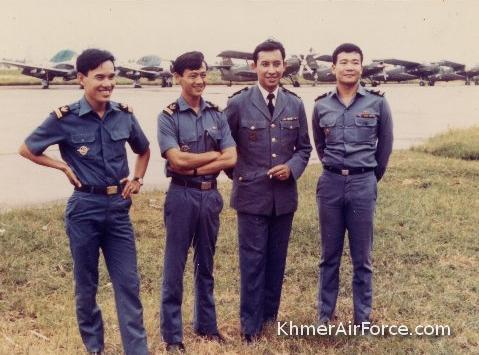 |
| L to R. : Lts S. Sivatha - K. Son Sann - S. Samyl - T. Kim Suor. In a few months, they will be rushed into the war. We won't see Sivatha et Son Sann anymore. Samyl will be seriously wounded. Suor will continue the war till the end. |